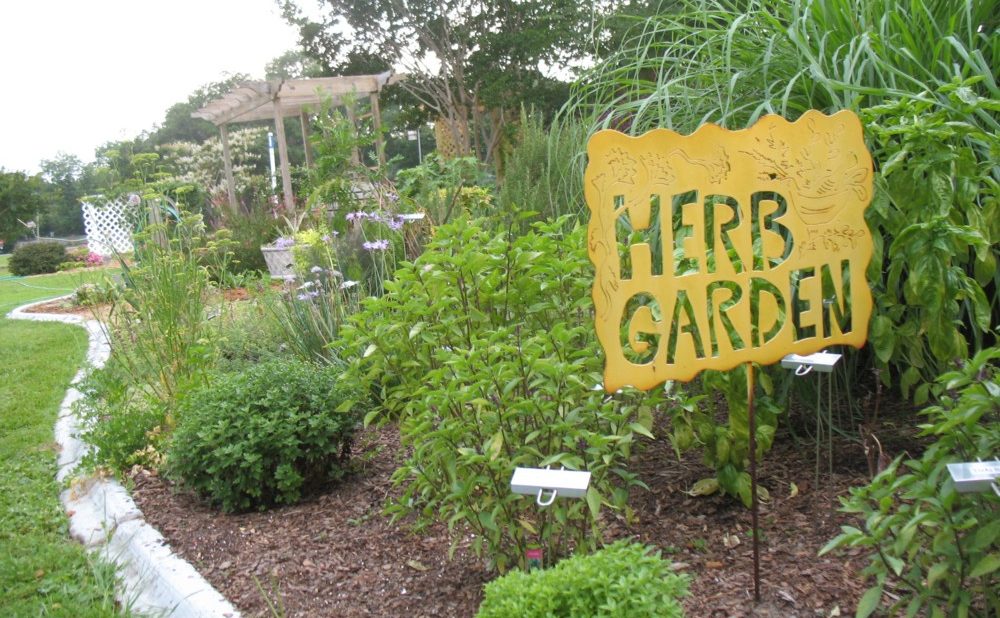
by Ashley Stonecipher | Dec 2, 2021
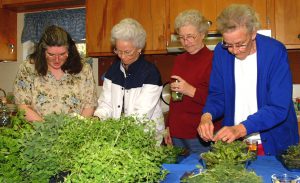
Women making vinegar at a class in Starke
Herbs are often underutilized in our cooking. There are many benefits of growing and using herbs. They add flavor to foods and beverages and reduce the need for salt, fat, and sugar. Herbs are also easy to grow at home and low maintenance!
Herbs can be used fresh, dried, and frozen. There are several tips of how to use herbs in your kitchen. You will need to adjust recipes depending on how the herb is prepared. For example, 1 tablespoon of finely cut fresh herbs equals 1 teaspoon of dried herbs and is equivalent to 1/4-1/2 teaspoon of ground dried herbs. It is always best to start with small amounts and add more to taste. Dried ground herbs can be used on meat, soups, sauces, and vegetables to name a few.
In hot dishes fresh herbs should be added near the end of the cooking time. If they are delicate herbs, you could do it in the last 1 to 2 minutes and less delicate herbs in the last 20 minutes of cooking. In cold dishes, herbs should be added several hours before serving or overnight. Each herb has its own flavor profile, so experiment and see which you like best! Some common herb and food combinations are basil and tomato products, rosemary and meats, sage and poultry, and mint and desserts. Have fun trying different combination of herbs and food and remember to start with little and add as needed for the desired taste!
Source: Minton, Emily and Maddox, Martha. 2018. “Cooking with Fresh Herbs.” UF/IFAS Extension. FCS8932/FY1209: Cooking with Fresh Herbs (ufl.edu)
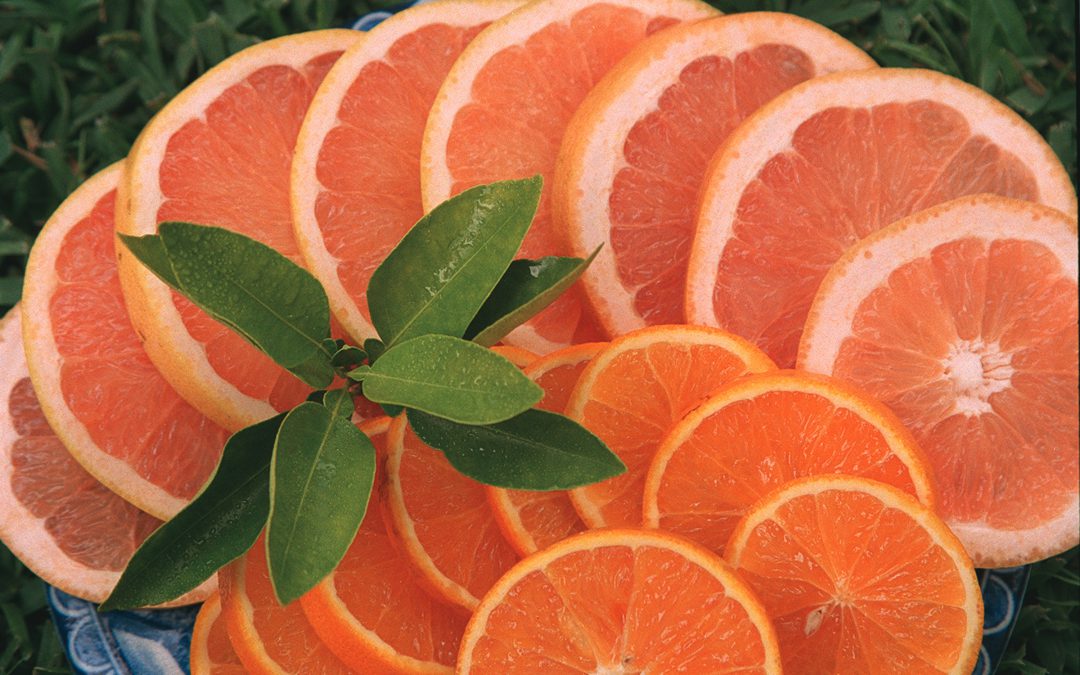
by Matthew Orwat | Nov 22, 2021
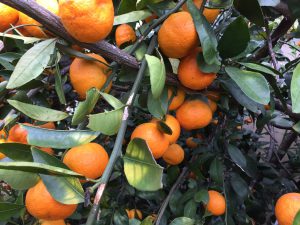
Citrus: Bearing Branches. Image Credit Matthew Orwat, UF/IFAS
Many dooryard fruit growers have asked me this Fall: When is the correct time to prune citrus? How do I prune Citrus right now? The answer may seem obvious, but when we delve into the question further, we find out that it is not.
Two different pruning strategies exist depending upon the citrus plants age. When training young citrus plants, it is essential to develop three to four main scaffold branches with wide crotch angles. This is done by selecting branches growing different directions that intersect with the trunk or each other at the widest angle possible. Other branches need to be pruned off and these need to be left alone to develop into the main scaffold. Once the branching system has been developed, traditional heading back, as seen in peaches and apples, is unnecessary.
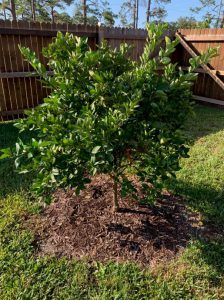
Young Citrus Tree with good vase shape
There are several instances in which pruning mature citrus trees is beneficial. First, branches should be pruned approximately one foot off the ground so developing fruit is not sitting on the ground. This also helps with weed control and fertilization. Next, it is important to remove growth that is positioned extremely upward or inward to promote an open, vase-shaped habit. Finally, it is necessary to remove any dead wood resulting from winter dieback.
Many growers are eager to remove branches that have been bent downward by heavy citrus crops. This is not necessary; they will bear well in subsequent years.
The last pruning item to consider is removal of suckers from below the rootstock. If the tree is grafted, this is necessary so that the rootstock does not overtake the scion cultivar. Trees propagated from seedage or cuttings will not need this type of pruning since root suckers will be true to type.
It has been noticed that when trees are not over pruned, they exhibit greater cold hardiness. Keeping that in mind, any pruning of citrus should be done at the beginning of March or later, not in the fall or early winter. With proper pruning practices, gardeners should expect healthy trees with bountiful harvests. For further information please consult the publications listed below or contact your local Extension office.
Citrus Culture in the Home Landscape
Cold Hardy Citrus for North Florida
Louisiana Home Citrus Production Manual
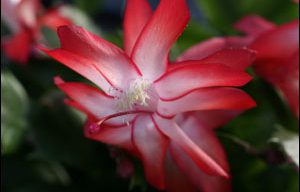
by Matt Lollar | Nov 22, 2021
Houseplants can soften up the interior of your home and help clean the air. They can also supplement your holiday decorations and help create stunning focal points. To help determine what plants do best under certain conditions and to give pointers on plant care, this month’s Gardening in the Panhandle LIVE! was all about houseplants.
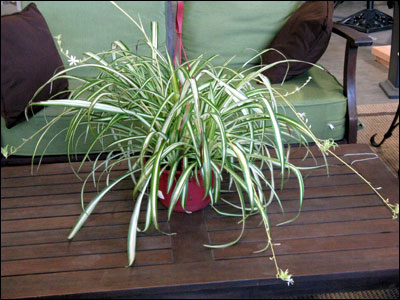
A spider plant on a coffee table. Photo Credit: University of Florida/IFAS
Environmental Conditions for Houseplants
Unless you live in a glass house, you’ll probably want to choose houseplants that do well in low light conditions. A guide for what light level different houseplants prefer can be found on the Gardening Solutions Light for Houseplants page. This page also provides useful tips on supplemental lighting.
Some houseplants are better at cleaning the air than others. A list of houseplants that do a good job improving indoor air quality can be found on the Gardening Solutions Houseplants That Clean the Air page.
The best way to determine if your houseplants need water is your own green thumb or whatever finger you choose to stick in the potting mix, but for some interesting information on outdoor soil moisture meters check out this informative publication on soil moisture sensors.
Houseplants need a good quality, well-drained potting mix to thrive. Tips on selecting a potting mix can be found on the Gardening Solutions Container Media page.
Houseplant Pests
One of the best ways to rid houseplants of insect pests is to set the plants outside for a few days and let the pests move on. For some information on pest control products in and around the home check out the publication Natural Products for Managing Landscape and Garden Pests in Florida.
Fungus gnats are mainly a nuisance, but some species can feed on living plant tissue. Darkwinged fungus gnats are known to feed on ferns, orchids, and geraniums.
Houseplant Propagation
One way to increase your houseplant population and save a few dollars is to propagate your own plants. The University of Florida/IFAS created the Plant Propagation Glossary to help with any propagation questions you may have.
Air layering is a propagation technique that not only allows the prospective plant to thrive from the nutrients of the mother plant, but it also saves space.
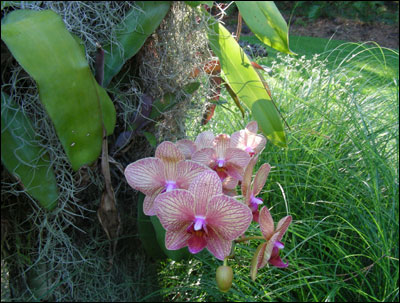
A moth orchid (Phalaenopsis spp.) outdoors. Photo Credit: University of Florida/IFAS
Specific Species Info
Orchids in the genus Phalaenopsis are easier to care for than other genera of orchids. The American Orchid Society provides some great tips on caring for orchids indoors. Some people choose to water their orchids with ice cubes. The Ohio State University has a publication that provides some more insight on watering Phalaenopsis orchids with ice cubes.
A lot of cacti do well indoors. A popular cactus during the holiday season is Christmas cactus. Christmas cactus have interesting foliage, but their blooms are what people want to see. Some tips on getting your Christmas cactus to bloom on time and general care information can be found in this Christmas Cactus Preparation fact sheet.
Have you ever wanted to grow fruit trees indoors or do you want some tips on bringing containerized fruit trees indoors for the winter? The Growing Fruit Crops in Containers publication provides some good tips on growing fruit trees indoors.
Unless you have a house with a lot of windows or a sunroom, plumeria don’t make the best houseplants. They need at least six hours of sunlight per day and need to be at least three years old to bloom. If you are interested in propagating plumeria, then check out this publication on propagating plumeria from cuttings.
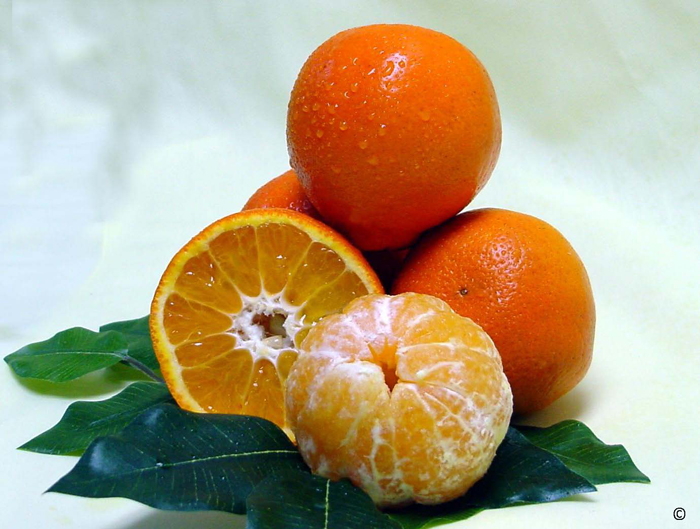
by Mary Salinas | Nov 22, 2021
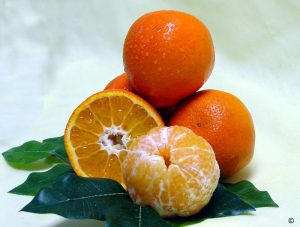
Sugar Belle mandarin cultivar. Mix of sweet Clementine and Minneola varieties. UF/IFAS File Photo.
Florida is known for citrus and many homeowners love to grow and enjoy it. However, a devastating disease known as citrus greening or HLB has taken a toll on commercial and residential citrus since it first was discovered in Florida in 2005.
Sugar Belle is a cultivar of mandarin citrus developed by the University of Florida citrus geniuses and is tolerant of citrus greening disease if it is properly planted and cared for. Tolerance of the disease does not mean that it doesn’t get citrus greening, rather it means that this cultivar can get infected but still be healthy and productive. The fruit of infected trees is safe to eat as the bacterium that causes it does no harm to humans.
Our chilly winters can be detrimental to many kinds of citrus, but Sugar Belle can withstand temperatures down to 14°F once the tree is well established. That is good news for us in the panhandle. Even so, it is best to choose a spot in your landscape with a southern exposure, preferably with a wind block from northwest winds. Avoid low areas as cooler air falls into those areas.
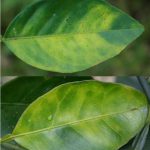
Symptoms of citrus greening on leaves show a blotchy mottled pattern. UF/IFAS photo.
Make your purchase from a certified nursery to make sure you are getting the right cultivar and a disease-free tree. Spring and fall are the best seasons of the year to plant citrus. When planting, make sure to make slices in the rootball if it is rootbound or if circling roots are present. The rootball should be slightly above the ground level after planting. All weeds and grass should be removed under the canopy of the tree to as they compete for water and nutrients with your newly planted tree. Never place mulch against the trunk as it can hold moisture there and promote disease. Water often the first year until well-established; after establishment citrus has some drought tolerance and may only need supplemental irrigation in times of heat and drought.
A good quality citrus fertilizer with micronutrients is crucial for a healthy tree with good quality fruit. The first fertilization should be about 3 weeks after planting and then follow the label directions for subsequent fertilizations. Newly planted trees should be fertilized 6 times in the first year and the fertilizer should be evenly broadcast under the tree canopy.
The only pruning in the first 3 years should be the removal of suckers that grow from the base, water shoots that grow quickly and straight up, and dead wood. Be sure to clean your pruning tools before and after each tree to avoid spreading any possible disease. First rinse off any dirt or other organic matter and then use a 3% bleach solution or alcohol for sterilization.
Happy Gardening!
For more information:
UF/IFAS Research on Development of Sugar Belle YouTube
Citrus Culture in the Home Landscape
Citrus Greening
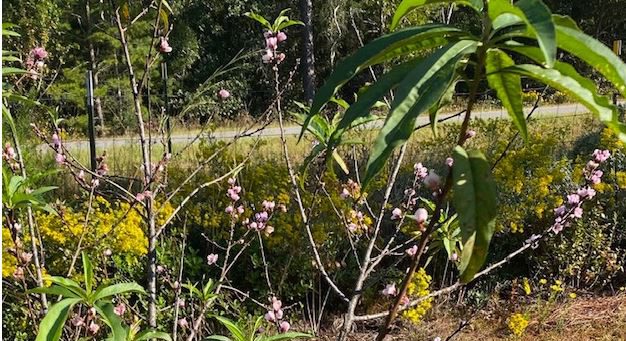
by Larry Williams | Nov 4, 2021
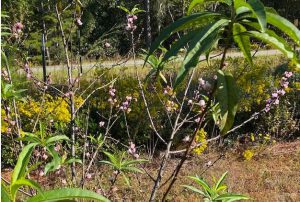
Peach tree blooming in fall. Note the yellow fall flowers of goldenrod & aster blooming in background. Photo credit: Leslie Hauquitz
Some fruit trees that normally bloom in late winter and spring are blooming now. Recently, a lady who had been out of town noticed that her peach trees were blooming when she arrived home. Knowing that peach trees ordinarily bloom around spring, she called me about this unusual occurrence. This unseasonal flowering also is occurring on some other fruit trees such as crabapple, apple and pear. This phenomenon also can occur in other deciduous spring flowering trees such as Japanese magnolia.
Anything that results in the leaves falling earlier than normal can result in this blooming out of season. Stresses that can result in the leaves falling prematurely include late season storms, insects and foliage diseases. This year’s excessive rains favored foliage diseases resulting in early leaf drop in many trees.
During most years, normal leaf drop in these trees occurs later in the season as the day length becomes shorter and when temperatures are cooler. Cooler temperatures prevent the flower buds from swelling and opening. However, if the leaves fall when the day length is longer and the temperature is warmer, the flower buds will swell and open. The leaves prevent the flower buds from developing. If the leaves fall early, during late summer or early fall, the flowers are allowed to open. With commercial apple production in some parts of the world, chemicals are applied to intentionally remove the leaves to force a second crop after harvesting the first crop of apples. This practice would not work in our area because there is not enough time to mature a second crop of fruit before cold weather arrives.
It is possible for a second crop of small fruit to develop on fruit trees that are blooming now as a result of the second flowering this year. However, because of the colder weather that will be arriving as we move into winter, any such fruit will not have time to mature. When the first killing frost or freeze occurs, these young fruits will be killed.
The lady who called about her peach trees wanted to know if she should remove the flowers and if this late flowering would negatively impact next spring’s flowering and fruit production. The flowers that opened this fall will be absent in spring – reducing the total number of flowers. However, during most springs, fruit trees produce more blooms and subsequently fruits than the trees can support. As a result, this unseasonable blooming should result in a needed thinning in next spring’s fruit crop.
So, there’s no need to remove them…just enjoy this “surprise” flower show.













